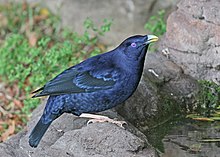| Bowerbirds Temporal range: Late Oligocene-present
| |
|---|---|

| |
| Male satin bowerbird Ptilonorhynchus violaceus | |
| Scientific classification | |
| Domain: | Eukaryota |
| Kingdom: | Animalia |
| Phylum: | Chordata |
| Class: | Aves |
| Order: | Passeriformes |
| Clade: | Eupasseres |
| Suborder: | Passeri |
| Family: | Ptilonorhynchidae G. R. Gray, 1841 |
| Type genus | |
| Ptilonorhynchus Kuhl, 1820
| |
| Genera | |
|
Ailuroedus | |
Bowerbirds (/ˈbaʊ.ərbɜːrd/) make up the bird family Ptilonorhynchidae. They are renowned for their unique courtship behaviour, where males build a structure and decorate it with sticks and brightly coloured objects in an attempt to attract a mate.
The family has 27 species in eight genera.[1] These are medium to large-sized passerines, ranging from the golden bowerbird at 22 cm (8.7 in) and 70 g (2.5 oz) to the great bowerbird at 40 cm (16 in) and 230 g (8.1 oz). Their diet consists mainly of fruit but may also include insects (especially for nestlings), flowers, nectar and leaves in some species.[2] The satin[3] and spotted bowerbirds[4] are sometimes considered agricultural pests due to their habit of feeding on introduced fruit and vegetable crops and have occasionally been killed by affected orchardists.[4]
The bowerbirds have an Australo-Papuan distribution, with ten species endemic to New Guinea, eight endemic to Australia, and two found in both. Although their distribution is centered on the tropical regions of New Guinea and northern Australia, some species extend into central, western, and southeastern Australia. They occupy a range of different habitats, including rainforest, eucalyptus and acacia forest, and shrublands. While the females are unequivocally drab, in some species the males have bright golden-yellow and sometimes black markings.[5]
One group with particularly inconspicuous plumage in males as well as females, but loud meowing calls, is known as "catbirds". Note that the ptilonorhynchid catbirds, the grey catbird (Dumetella carolinensis) and black catbird (Melanoptila glabrirostris) from the Americas, and the Abyssinian catbird (Sylvia=Parophasma galinieri) from Africa, are only related by their common name; they belong to different families.
- ^ Borgia, Gerald (June 1986). "Sexual Selection in Bowerbirds". Scientific American. 254 (6): 92–101. Bibcode:1986SciAm.254f..92B. doi:10.1038/scientificamerican0686-92. JSTOR 24975977.
- ^ Cite error: The named reference
EoBwas invoked but never defined (see the help page). - ^ "Problem Wildlife". Dse.vic.gov.au. 2013-02-27. Archived from the original on 2013-04-28. Retrieved 2013-03-27.
- ^ a b "Spotted Bowerbird" (PDF). Archived from the original (PDF) on 2014-02-17. Retrieved 2013-03-27.
- ^ Rowland, Peter (2008). Bowerbirds. Australian Natural History Series. Collingwood: CSIRO Publishing. pp. 1–26. ISBN 978-0-643-09420-8.